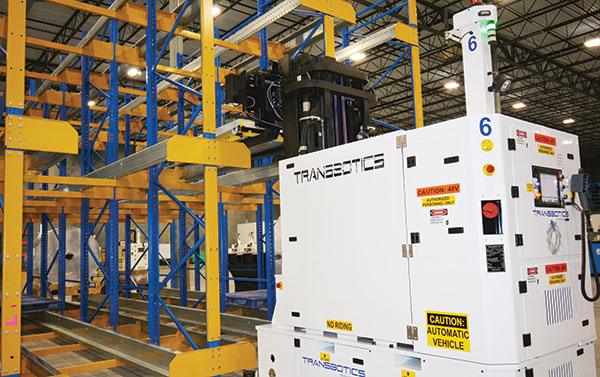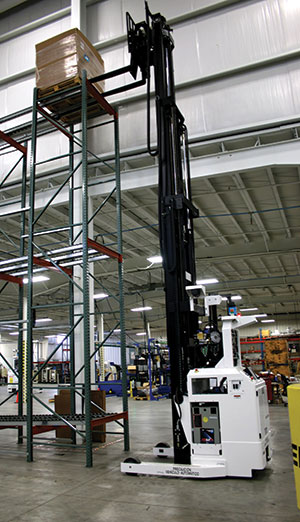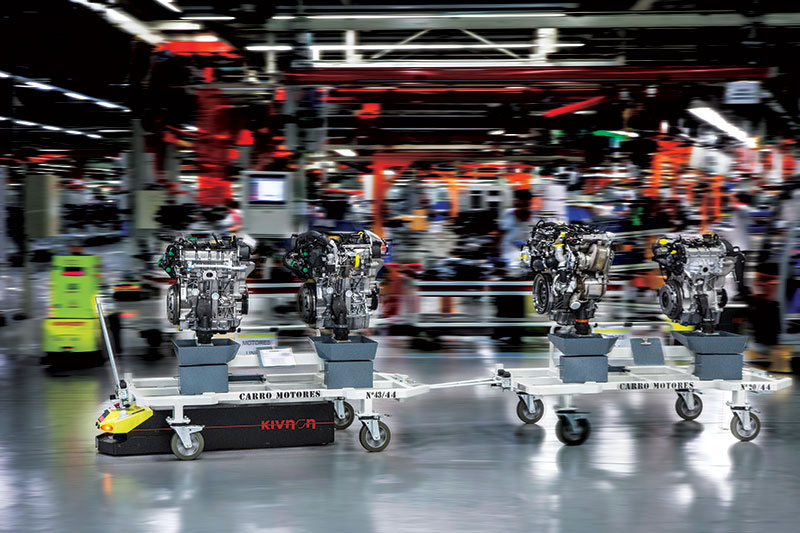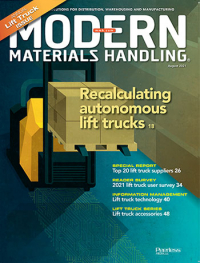AGVs gain in flexibility and applications
Once thought of as reliant on fixed guidance infrastructure and aimed at moving larger loads across facilities, the automatic guided vehicle evolved. AGVs today can move loads large and small, and some can reliably lift multiple levels high. Some now even use natural feature navigation and collaborate more closely with people.
There used to be clearly definable differences between the decades-old category of automatic guided vehicles (AGVs) and the newer wave of autonomous mobile robots (AMRs), which have gained attention by automating much of the legwork involved in e-commerce order picking.
AGVs are considered proven and reliable for what they’ve done since the 1950s—moving larger loads within industrial facilities—but haven’t been thought of being dynamic in terms of either route navigation or changing workflows. AGVs may have their place—or so the perception goes—but they represent an older way of moving materials that isn’t flexible enough. But, it just may be time to throw out this perception of AGVs.
Many AGVs still use some type of guidance infrastructure like reflectors to help navigate, but others use a more autonomous “natural navigation” approach. And while the AGV sweet spot remains moving unit-sized loads, some AGVs can now assist in goods-to-person order picking, while conversely, some AMRs can move and lift pallet-sized loads.
Both categories are growing. According to analyst firm Interact Analysis, the AGV market will grow by 11% in 2020, even with Covid-19 disruption factored in, although the AMR market will grow by 45% this year. The analyst firm groups the two markets together under a “mobile robotics” assessment.
AGVs are in a good place, say vendors, even if AMRs are dominating the high growth niche of e-commerce order picking. AGVs are proven, are growing in the applications they can handle, and aren’t inflexible. And while many AGVs do rely on guidance infrastructure to know where they are at (known as localization), that foundation for navigation is reliable and precise.

“There are places where AGVs are a good fit and also places where AMRs have a good fit,” says Chuck Russell, vice president of sales with Transbotics, an AGV vendor that is part of Scott Systems. “AGVs are a more mature product segment. They are solid and reliable, and many operations are attracted to that.”
Differences exist
While it’s been decades since AGVs used wire embedded on the floor to navigate, many AGV models today and most installed systems use some type of special guidance infrastructure to localize and be able to do their tasks. Reflectors, for example, can be placed on site features like walls or rack to provide localization reference points.
Once this base infrastructure is in place and a digital map and vehicle routes are established, it’s a relatively easy, software-driven exercise to create a new route or drop off point, says Nick Ellens, executive manager of automated vehicle engineering with Daifuku, an AGV vendor.
“Each vehicle understands where these targets are,” says Ellens. “It can localize itself anywhere within that field. So, changing the path of a vehicle within this known world is simple. And, if you want to add new paths to areas of a facility that haven’t had them before, it’s not an arduous thing. Yes, the targets would need to go up with a laser navigation system, but once these are learned by the system, you have the freedom to make changes anywhere within that field.”
Ellens also points out that some AGVs now use natural feature-based navigation in which sensors on the vehicles are used to capture the location of fixed facility features. In effect, there is no one way that today’s AGVs localize. “One of the great things about AGVs and AGV providers is that we’ve developed different navigation styles and technologies over the years, and we’re able to offer an approach which fits the particular facility,” says Ellens.
For many sites, using some guidance infrastructure is not a detriment if it permits a high level of repeatability and defined pathways and stop-off points. “What the traditional style of navigation brings to the table is a really high level of determinism,” says Ellens. “It can help an operation to have a well-defined interaction between the AGVs and with humans or with other automation in the facility.”
According to Brian Spradlin, vice president of mobile automation with KION, which provides AGVs and also AMRs (Dematic, part of KION, recently launched a partnership with an AMR vendor), the key difference between AGVs and AMRs remains that AGVs follow a predefined path, whereas AMRs develop their routes dynamically.
What’s more, Spradlin adds, “functionally, AGVs and AMRs are more alike than different. They both can transport an item to and from a location. To date, AGVs have focused on full pallet loads, while most AMRs have focused on transporting totes, but this distinction is changing.”
Given that distinctions are blurring, it’s best for users to consider functional questions like what type of product needs moving, weight and dimensions of loads, and lifting requirements, including how high. The answers to such questions will help determine if the right solution is AGVs, AMRs or perhaps a combination, Spradlin advises. “Deciding whether to select an AGV or AMR is about users looking at their operation holistically and then determining the best solution to fit their needs,” he says.
AGVs’ changing definition
Defining an automatic guided vehicle (AGV) used to hinge on the fact that most AGVs use some form of special infrastructure for localization and to establish a foundation for navigation, rather than navigate autonomously. But with the increased use of natural feature navigation by AGV vendors, that trusty definition doesn’t quite fit all AGVs now on the market, though it holds true for many deployed systems.
Multiple AGV providers are using natural feature navigation, says Matt Wade, head of marketing for BlueBotics, a company that provides natural feature navigation technology to both AGV and AMR vendors.
The way it works, he adds, is that the BlueBotics software takes in data from laser scanners and sensors that are onboard an AGV. One AGV is used to digitally map the permanent features like walls or fixed rack to create digital reference points for localization. Routes are created based on this digital map, to be used across the fleet of AGVs. Software provides the AGVs with what amounts to virtual guide paths.
“With our technology, we don’t see a huge difference between how [AGVs and AMRs] navigate,” says Wade. “We think both type of vehicles can benefit from the flexibility of a natural navigation approach.”
AGV vendors can use the BlueBotics software to allow for autonomous obstacle avoidance, but most AGV vendors use it in a “virtual guide path” mode, says Wade, under which if an AGV senses an obstacle, it stops and waits for it to be cleared before proceeding. Adding a new path or handling point is a software-driven change.
“Once that digital map is established and routes are approved, each AGV knows where it is, it knows its route, and it can go about doing its work,” Wade says.
There are more similarities than differences between AMRs and AGVs today, says Michael Fleming, product manager of AGV and AMR solutions for MHS Global, a provider of materials handling automation solutions. While much is made of the fact that most AGVs use some type of guidance infrastructure like reflectors, Fleming points out that this infrastructure is typically used to aid in “localization” and AGVs still have on-board intelligence and sensing that help them navigate and operate safely.
“Today, there isn’t that much difference in terms of what they can do or even in how they navigate,” says Fleming. “The bigger difference comes down to the mentality of how the solutions are deployed and work. AMR solutions are more task focused, decentralized and autonomous, and the vendors tend to work directly with the end users, including providing them with fleet software. The AGV vendors and their solutions tend to be more centralized and fleet focused. They also tend to hold on to the fleet software and make changes to the system for the user, sometimes with an integrator involved.”
AMRs generally are more flexible than AGVs, says Fleming, but AGV infrastructure and workflows can be changed by the vendor or integrator when the need arises. “Rather than focus on the technical differences in navigation, it’s better to focus on what type of tasks you need done, how centralized an approach you wish to have, and go from there.”
The strong points of AGVs are many, Spradlin adds, including the ability to operate in harsh environments such as frozen storage, or transport extremely large, heavy or odd-shaped loads. As far as pallet lifts are concerned, AGVs can accurately place loads higher than 40 feet into racking, or perform other advanced tasks, such as automatic trailer loading.

In short, AGVs have earned a reputation as being precise and consistent, which Spradlin sees as being attractive to operations with narrow aisles or limited space for material movement routes. “The aisles of most current warehouses, distribution centers and manufacturing lines are narrow and demand predictable and repeatable paths for mobile automation,” he says. “AGVs are well suited to those needs.”
Almost every vertical has adopted AGVs, says Russell, including large verticals like food and beverage, and more niche segments like tire manufacturing, which has the need to automate the movement of tires through different stages in production and distribution.
In warehousing, AGV lift trucks can replace many highly repetitive tasks, adds Russell. “They aren’t going to replace every task that conventional forklifts are used for, but they are ideal for automating the highly repetitive, mundane tasks,” he says.
The applications for AGVs span many industries, especially for repetitive tasks, agrees Ellens. Heavy-duty AGVs can also move the heaviest of loads, such as steel plates, paper rolls and aluminum coils. Today’s AGVs can also interact with human workers or with other forms of automation like conveyor or palletizers through system integration. “AGVs can now do well with collaborative processes, and this allows the workforce to focus on tasks that are less feasible to automate,” Ellens says.
Cross pollination
Some AGVs are now designed to move totes or other relatively smaller loads, while AMR navigation has evolved to serve as the smarts for robotic lift trucks and tuggers that move pallets. For example, AGV provider Grenzebach offers AGVs and mobile storage units used for good-to-person order picking, and has had this solution piloted in the United States by third-party logistics company GEODIS.
On the other hand, vendors with AMR technology such as Vecna Robotics offer multiple models used to move larger, pallet-sized loads, as well as smaller loads. The upshot of all this evolution, says John Hayes, vice president of sales with Vecna, is the notion that larger loads call for AGVs is no longer valid.
“You can’t go by form factor alone,” says Hayes. “Our vehicle technology, for example, is an AMR with respect to how they navigate, but in terms of being able to handle larger loads, they have the application suitability of an AGV.”
Hayes does see some AGVs beginning to use natural navigation, but points out that on the whole, most AGVs follow predefined paths, though they have safety sensors to stop on a dime if need be. “The AMR concept just means that the vehicles can path plan versus path follow,” says Hayes. “It’s really that one fundamental difference that changes AGVs to AMRs. An autonomous vehicle can think about the environment and react versus follow a defined path.”
Seegrid, which offers infrastructure free, vision-guided vehicles, uses an autonomous navigation approach, says Jeff Christensen, vice president of Product at Seegrid, and its vehicles handle pallet-sized loads.
Christensen points out that while there are similarities in some of the sensors used by AGVs and AMRs, and overlap in the load sizes they can handle, most AGVs rely on infrastructure to localize, whereas AMRs are autonomous and as result, more highly dynamic.
In the past, says Christensen, installing infrastructure “was the only game in town” for allowing mobile automation to perform with high reliability, but now that autonomous navigation is proven effective, you can have both reliable, automated moves and a level of operational flexibility more akin to human-operated vehicles.
“The tradeoff historically has been that I can have the flexibility of human driven vehicles, or the predictability of automation,” Christensen says. “The real sea change that has happened in this mobile automation industry in the last five to 10 years is that you no longer have to make that tradeoff. There is now technology that can navigate well autonomously, so you get both predictability and flexibility.”
Companies mentioned in this article:

Article Topics
AGVs and AMRs News & Resources
2024 Intralogistics Robotics Survey: Robot demand surges Autonomous mobile robots (AMRs) on a mission K.Hartwall and its Australian distribution partner, Retailquip, join forces Pramac partners with BlueBotics to launch line of ANT driven mobile robots Mitsubishi Logisnext partners with Jungheinrich to introduce Rocrich AGV Solutions CaPow’s power-in-motion solution eliminates charging downtime Conveyco unveils All-Temp AMRs that can move between frozen, chilled and ambient warehouses More AGVs and AMRsLatest in Materials Handling
Registration open for Pack Expo International 2024 Walmart chooses Swisslog AS/RS and software for third milk processing facility NetLogistik partners with Vuzix subsidiary Moviynt to offer mobility solutions for warehouses Materials Handling Robotics: The new world of heterogeneous robotic integration BSLBATT is looking for new distributors and resellers worldwide Lucas Watson appointed CSO for Körber’s Parcel Logistics business in North America Hyster recognizes Dealers of Distinction for 2023 More Materials HandlingAbout the Author
Subscribe to Materials Handling Magazine

Find out what the world's most innovative companies are doing to improve productivity in their plants and distribution centers.
Start your FREE subscription today.
April 2024 Modern Materials Handling

Latest Resources












